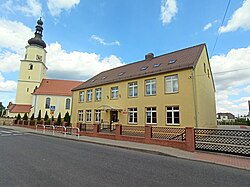Strzeleczki
Strzeleczki
Klein Strehlitz | |
|---|---|
Town | |
 Saint Martin church and primary school | |
| Coordinates: 50°28′N 17°52′E / 50.467°N 17.867°E | |
| Country | |
| Voivodeship | Opole |
| County | Krapkowice |
| Gmina | Strzeleczki |
| Founded | 13th century |
| Population | |
| • Total | 1,598 |
| Time zone | UTC+1 (CET) |
| • Summer (DST) | UTC+2 (CEST) |
| Vehicle registration | OKR |
| Voivodeship road | |
Strzeleczki [stʂɛˈlɛt͡ʂki] is a town in Krapkowice County, Opole Voivodeship, in southern Poland. It is the seat of the gmina (administrative district) called Gmina Strzeleczki.[1] It lies approximately 8 kilometres (5 mi) west of Krapkowice and 23 km (14 mi) south of the regional capital Opole. Historically located in Upper Silesia, in the Prudnik Land. It is situated on the Biała River, a tributary of Osobłoga.
Since 2006 the settlement, like the entire county, has been officially bilingual in Polish and German.
Demographics[edit]
The town has one of the highest concentrations of Germans in Poland, with 18 of 20 seats on the municipal council filled by Germans.
History[edit]


The market settlement of Strzeleczki was founded in the early 13th century, when it was part of fragmented Piast-ruled Poland.[2] Its name, first recorded as Strelicz is derived from an Old Polish word strzelec, which means "archer" or "hunter".[2][3] In 1327, it was granted town rights; by this point it was already quite large with a parish church, and since 1375 a school functioned in the town - one of the oldest in Upper Silesia.[2]
On March 13, 1428, the town was looted and burned by the Hussites. In 1531 the town's name was recorded in a Latin form as Parva Streletz, and in 1535 as Klein Streletz in German. This was to distinguish it from the nearby town of (Groß) Strehlitz (Strzelce Opolskie). The town was again destroyed by Swedish forces during the Thirty Years' War in 1642.[2]
In 1742 it came under Prussian control within which it was officially known under the Germanized name Klein Strehlitz. In 1750 it lost its town rights. When the Archipresbyteriate of Oberglogau (Głogówek) was divided, Klein Strehlitz was left with a dean, and until today there is a small deanery in the town. The inhabitants of Klein Strehlitz were always Catholic; in the census of 1861, there were 1370 Catholics, 13 Protestants, and 15 Jews. Four annual fairs were held in the village in the late 19th century.[4] Before they died out in 1769 the town belonged to the counts of Proskau (Prószków), passing then to the counts of Schelitz (Chrzelice), and then in 1789 to the Prussian state. Until 1945 it belonged to the district of Landkreis Neustadt O.S.
In the Upper Silesia plebiscite of 20 March 1921 1381 villagers voted to remain with Germany and 198 voted to join the newly reborn state of Poland.[5] As a result, Klein Strehlitz remained in Germany. In 1939 the village had 1875 inhabitants.
With the defeat of Germany in World War II, in 1945, the village became again part of Poland. The German population of was largely expelled[citation needed] in accordance with the Potsdam Agreement. The historic Polish name of Strzeleczki[3][4] was confirmed official in 1946.[6] Administratively it became part of the Silesian Voivodeship. In 1950 it was reassigned to Opole Voivodeship, and in 1999 reassigned from Prudnik County to Krapkowice County. On 17 May 2006 the entire commune of Strzelecki was declared bilingual in Polish and German, and on 24 November 2008 the German name Klein Strehlitz was also made official.
Coat of arms[edit]
The coat of arms of the town most likely comes from the Barons of Promnitz-Pless. The current emblem is based on a drawing made by Heraldic artist Otto Hupp in 1898.
Sights[edit]
Landmarks of Strzeleczki are the Baroque Saint Martin church and the Exaltation of the Holy Cross church. There is an old monument of Saint John of Nepomuk. There are graves of Polish troops killed during World War II, a war memorial dedicated to soldiers from the village who died in World Wars I and II, and a grave of Włodzimierz Prokaziuk, a Polish man executed by the Germans during World War II.
Notable people[edit]
- Lothar Stark (1876–1944), film producer
References[edit]
- ^ "Central Statistical Office (GUS) - TERYT (National Register of Territorial Land Apportionment Journal)" (in Polish). 2008-06-01.
- ^ a b c d "Strzeleczki". Urząd Gminy Strzeleczki (in Polish). Retrieved 26 November 2023.
- ^ a b Damrot, Konstanty (1896). Die älteren Ortsnamen Schlesiens, ihre Entstehung und Bedeutung. Mit einem Anhange über die schlesisch-polnischen Personennamen. Beiträge zur schlesischen Geschichte und Volkskunde (in German). Verlag von Felix Kasprzyk. p. 115.
- ^ a b Słownik geograficzny Królestwa Polskiego i innych krajów słowiańskich, Tom XI (in Polish). Warszawa. 1890. pp. 460–461.
{{cite book}}: CS1 maint: location missing publisher (link) - ^ Results of the Upper Silesia plebiscite (in German) Archived 2017-01-29 at the Wayback Machine
- ^ Rozporządzenie Ministrów: Administracji Publicznej i Ziem Odzyskanych z dnia 12 listopada 1946 r. o przywróceniu i ustaleniu urzędowych nazw miejscowości., M.P. z 1946 r. Nr 142, poz. 262


